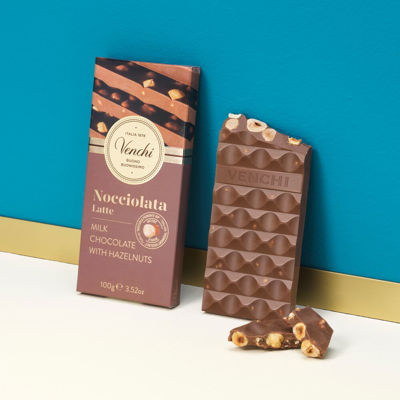
Milk Chocolate: Properties and Benefits
People have always been divided into lovers of milk chocolate and fans of dark chocolate...But what makes these two types of chocolate so different? To be called milk chocolate, it must contain at least 25% cocoa and 14% milk-derived substances. Generally, the ingredients used to make milk chocolate are: sugar, milk powder, cocoa butter, cocoa mass, soy lecithin and vanilla.
Characteristics
It's much sweeter than dark chocolate because it contains less cocoa and more sugar and is less solid because of the milk fat it contains, which melts easier than cocoa butter. Typically light brown in colour, milk chocolate has a cocoa-rich aroma with hints of caramel, milk and vanilla, and a sweeter and more persistent taste.
Taste-wise, the second you put a small piece on your tongue, the chocolate melts and envelops your palate with its delicious flavor. Rather than distracting from the taste of the chocolate, milk helps bring out the flavor notes of the cocoa and the other ingredients. What's important is ensuring that the balance between cocoa and milk is just right. To maintain the perfect level of intensity, we at Venchi created our Milk Chocolate with 47% Venezuelan cocoa. This recipe has won numerous awards, including the Tavoletta D'oro 2020, thanks to its unique flavour. The single-origin cocoa from Venezuela releases hints of dried fruit, cherries and milk, giving the milk chocolate a taste that fans of dark chocolate will also love, thanks to the 47% cocoa content.
Milk chocolate also works perfectly with Piedmont hazelnuts. Examples include our Hazelnut bars and hazelnut spread with Extra Virgin Olive Oil. With its uniquely sweet flavour, this type of chocolate also works perfectly with crunchy, gluten-free hazelnut biscuit (see our Baciodidama range).
As it's the type of chocolate preferred by children, it's perfect for making cakes, muffins and other tasty snacks. It can be enjoyed with fruit, yoghurt and cereal.
Nutritional values
NUTRITIONAL VALUES |
PER 100 g |
Energy |
2385 Kj - 570 Kcal |
Fats |
36 g |
Of which saturates |
21.6 gr |
Carbohydrates |
53.2 gr |
Of which sugars |
51.9 gr |
Protein |
7.4 gr |
Sodium |
0.3 gr |
Unlike dark chocolate, milk chocolate contains less cocoa and a higher amount of sugar, so it's important to avoid eating too much of it in order to benefit from all the positive properties for our health and well-being, such as polyphenols, natural antioxidants that help improve heart and circulatory functions and tryptophan, which stimulates the release of serotonin (the hormone that makes us feel good!), without consuming too much sugar and fat.




















